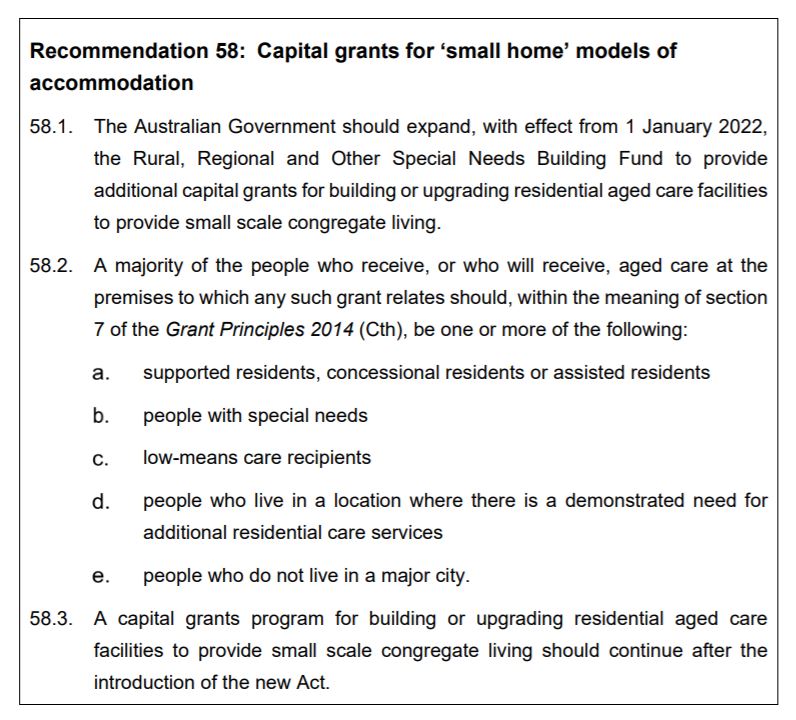The Royal Commission into Aged Care Quality and Safety concluded its final hearing last Friday with Senior Counsel outlining 124 proposed recommendations and an “ambitious” five-year timeline for transforming Australia’s aged care system. Among the recommendations were two that could signal a significant shake-up for aged care accommodation within four years – and village and land lease operators could be the unexpected beneficiaries.
The first recommendation is:
Recommendation 57 – Improving the design of aged care accommodation
This would happen through a three-stage process:
- developing and publishing a comprehensive set of national aged care design principles and guidelines on accessible and dementia-friendly design for residential care by 1 July 2022 that would be able to be applied to ‘small home’ as well as reablement and respite settings and could be updated from time to time to reflect contemporary best practice;
- implementing a program to adopt these principles and guidelines by 1 July 2023 including industry education and financial incentives for buildings that comply with these guidelines; and
- amending the National Construction Code so new developments are informed by these principles and guidelines by 1 July 2025.
 ‘Big boxes’ out, smaller homes in
‘Big boxes’ out, smaller homes in
In short, aged care providers will be expected to move to smaller-scale housing models integrated within the local community within four years.
Senior Counsel Assisting Peter Rozen QC (pictured above) said the staged process was designed to give the sector “advanced notification” of the changes under a “sensible” four-year plan – and aim to reverse the trend towards larger, more institutional residential care which he blamed on the lack of leadership of the aged care sector by the “system governor” i.e. the Commonwealth.
“That’s a product of the market in operation, essentially, of the lack of steering by the system governor that’s allowed accommodation – residential aged care accommodation to grow in size, particularly in the last ten years, and it would seem that unless there is some policy intervention, those trends will continue,” he said.
Financial incentives for thinking ‘small’
This process would be supported by:
Recommendation 58: Capital grants for ‘small home’ models of accommodation
This would see the Rural, Regional and Other Special Needs Building Fund expanded from 1 January 2022 – 14 months away – to provide additional capital grants for building or upgrading residential aged care facilities to provide small scale congregate living.
Mr Rozen added that smaller-scale accommodation didn’t have to be provided by smaller-scale providers – and larger-scale operators may be better equipped in terms of workforce to adapt to this model of accommodation.
“It could be that larger scale providers could still benefit from those sorts of economies of scale that I’ve referred to but do so whilst providing smaller scale accommodation along the lines we’ve discussed in this part of the submissions,” he said.
Smaller homes favoured for providing better quality of life
However, the message from the Counsel Assisting – and their 475-pages of submissions – was clear: ‘big box residential care is out – and care at home and in smaller, home-like accommodation is in.
“In broad terms, good design in residential aged care, particularly for people living with dementia, will usually involve less institutional settings and smaller, lower density congregate living arrangements,” their submissions state.
“Smaller, lower density congregate living arrangements promote better quality of life, particularly for people living with dementia.”
European aged care providers already moving to smaller-scale models
This is not a new concept.
In Europe, aged care providers are already moving towards ‘small home’ models as the norm. Last year, the peak body representing European providers, the European Ageing Network (EAN) revealed its vision for long-term care from 2030 – aged care focused on quality of life and social supports and services.
There is a strong argument that there is no better place for an ageing person to receive both of these than by living in a retirement village or land lease community.
COVID to further drive demand for retirement housing
COVID has further highlighted the attractive combination of safety, security and community provided by retirement living – and this is already being felt in other markets such as New Zealand and the UK (see this story).
The Royal Commission provides a unique opportunity for village and land lease operators to capitalise on this position by delivering care and supports into their communities and developing new and innovative models that offer an alternative to the ‘big boxes’ now out of favour.
The question is: how many in the sector will seize this chance?










